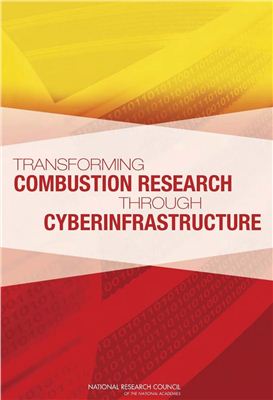NA Press, 2011. 117 p. ISBN:0309163870 9780309163873
This is a study of the structure and use of a cyberinfrastructure for combustion research. The trends in the continued use of fossil fuels and likely use of alteative combustion fuels call for more rapid development of improved combustion systems.
Combustion has provided society with most of its energy needs for millenia, from igniting the fires of cave dwellers to propelling the rockets that traveled to the Moon. Even in the face of climate change and the increasing availability of alteative energy sources, fossil fuels will continue to be used for many decades. However, they will likely become more expensive, and pressure to minimize undesired combustion by-products (pollutants) will likely increase.
Contents
Summary
Introduction
Alteative Energy Sources
Cyberinfrastructure in Combustion
Organization of the Report
References
Cyberinfrastructure
Defining Cyberinfrastructure
Building a Community Cyberinfrastructure as Distributed Collaboration
The Challenges Facing a Combustion Cyberinfrastructure
The Petascale Frontier and the Exascale Challenge
Cyberinfrastructure and Digital Research Collections
Evolution of Data Collections
Data-Curation Aims and Challenges
Filling Data Gaps
Aligning with the Combustion Community
Measuring Progress
Expanding Access to the Community
Science Gateways
NanoHUB
Cloud Computing
Scientific Work Flow
References
Combustion and Cyberinfrastructure
Overview
How Individual Researchers Would Benefit from a Combustion Cyberinfrastructure
A Hierarchical Approach to Combustion Modeling
Combustor Configurations
Models, Submodels, and Reductions
Data and Data Flow
Species-Based Data
Chemical Databases
Continuum-Based Data
Data Flow
Cyberinfrastructure: A New Mode of Organization for a Community-Level Vision in Combustion Research
References
Recommendations
A Cyberinfrastructure to Connect Combustion Research Communities
Organizational Structure of Proposed Cyberinfrastructure
Implementation Plan
A Cyberinfrastructure as an Educational Tool
Changes in Educational Programs
Educational Components
Budgetary Issues
References
Appendixes
A The GRIMech Model
B CHEMKIN Chemical Kinetics Software
C Direct Numerical Simulations
D Chemical Kinetic Reaction Mechanisms
E Committee Meeting Agendas
F Biographies of the Committee Members
This is a study of the structure and use of a cyberinfrastructure for combustion research. The trends in the continued use of fossil fuels and likely use of alteative combustion fuels call for more rapid development of improved combustion systems.
Combustion has provided society with most of its energy needs for millenia, from igniting the fires of cave dwellers to propelling the rockets that traveled to the Moon. Even in the face of climate change and the increasing availability of alteative energy sources, fossil fuels will continue to be used for many decades. However, they will likely become more expensive, and pressure to minimize undesired combustion by-products (pollutants) will likely increase.
Contents
Summary
Introduction
Alteative Energy Sources
Cyberinfrastructure in Combustion
Organization of the Report
References
Cyberinfrastructure
Defining Cyberinfrastructure
Building a Community Cyberinfrastructure as Distributed Collaboration
The Challenges Facing a Combustion Cyberinfrastructure
The Petascale Frontier and the Exascale Challenge
Cyberinfrastructure and Digital Research Collections
Evolution of Data Collections
Data-Curation Aims and Challenges
Filling Data Gaps
Aligning with the Combustion Community
Measuring Progress
Expanding Access to the Community
Science Gateways
NanoHUB
Cloud Computing
Scientific Work Flow
References
Combustion and Cyberinfrastructure
Overview
How Individual Researchers Would Benefit from a Combustion Cyberinfrastructure
A Hierarchical Approach to Combustion Modeling
Combustor Configurations
Models, Submodels, and Reductions
Data and Data Flow
Species-Based Data
Chemical Databases
Continuum-Based Data
Data Flow
Cyberinfrastructure: A New Mode of Organization for a Community-Level Vision in Combustion Research
References
Recommendations
A Cyberinfrastructure to Connect Combustion Research Communities
Organizational Structure of Proposed Cyberinfrastructure
Implementation Plan
A Cyberinfrastructure as an Educational Tool
Changes in Educational Programs
Educational Components
Budgetary Issues
References
Appendixes
A The GRIMech Model
B CHEMKIN Chemical Kinetics Software
C Direct Numerical Simulations
D Chemical Kinetic Reaction Mechanisms
E Committee Meeting Agendas
F Biographies of the Committee Members

